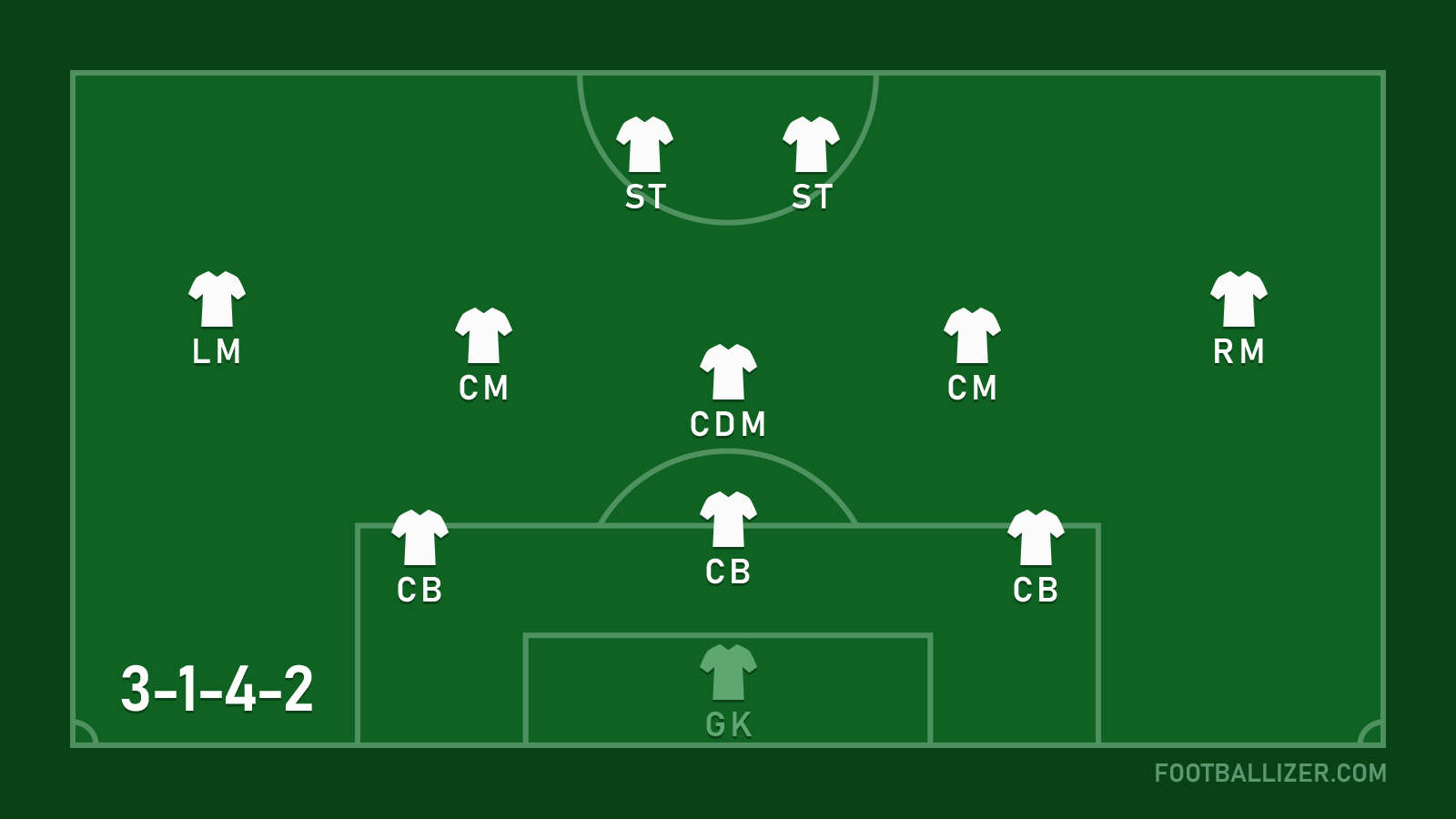3-1-4-2 Formation

The 3-1-4-2 formation is a variation of the traditional 4-4-2 formation. It consists of three central defenders, one defensive midfielder, four central midfielders, and two forwards. this formation is suitable for games you're attempting to win while you also need to allow no goals or fewer goals to be scored. Here is a breakdown of the positions:
- Three central defenders: These players are responsible for defending the center of the field and protecting the goalkeeper.
- One defensive midfielder (CDM): This player sits in front of the defense and is responsible for breaking up opposing attacks and starting counter-attacks.
- Four central midfielders (CM): These players are split into two pairs. The pair closest to the defense is responsible for helping the defensive midfielder in breaking up attacks and providing cover. The pair closest to the forwards is responsible for creating chances and supporting the attack.
- Two forwards (ST): These strikers are responsible for scoring goals and applying pressure to the opposition defensive line.
This football formation is a balanced formation that allows for both defensive solidity and attacking threat. The three central defenders provide a solid defensive base, while the defensive midfielder (CDM) shields them and breaks up opposing attacks. The four central midfielders (LM, RM, CM and CM) )provide a good mix of attacking and defensive qualities, while the two strikers in front provide a goal threat.
This formation may leave the flanks exposed, making it susceptible to wide-player teams. If the CMs are not disciplined in their positioning, they can leave the defensive midfielder (CDM) isolated and vulnerable to counter-attacks by the opponent. As with any formation, it is up to the coach to decide whether the 3-1-4-2 is the best fit for their team based on the strengths and weaknesses of the players available and the opposition they are facing.
Advantages
Balanced
The 3-1-4-2 formation provides a balance between defense and attack. With three CBs and a CDM, it ensures that the team has enough cover at the back, while the four midfielders and two attacking players provide goal scoring opportunities.
Flexibility
The 3-1-4-2 configuration is extremely adaptable and is simple to modify to fit various match circumstances. The team can switch to a more defensive or attacking formation depending on the scoreline and the opposition.
Midfield Dominance
The 3-1-4-2 formation allows the team to dominate the middle of the field, as there are four midfielders who can control the game and create opportunities for the strikers.
Disadvantages
Vulnerability on the Flanks
Thia formation can be vulnerable to attacks from the sides, as there are only three defenders who may struggle to deal with wingers who are good at crossing the ball.
Over-reliance on Midfielders
It also can lead to an over-reliance on the midfielders to create scoring opportunities, which may put too much pressure on them and make them prone to mistakes.
Limited Width
The 3-1-4-2 is not very wide, as there are only three defenders and four midfielders who may not be able to play wide enough for creating space for the forwards.
How to Counter 3-1-4-2 Formation?
A formation that can be effective against the 3-1-4-2 formation, is the 4-3-3 formation. In a 4-3-3 formation setup, there are four defenders, three central midfielders, and three forward players. This formation can help counter the 3-1-4-2 formation in the following ways:
The 4-3-3 offers greater defensive stability, with four defenders providing better cover against the opposition's two forwards.
The three central midfielders can help control the game and disrupt the opposition's midfield dominance, limiting their ability to create scoring opportunities.
The wide forwards in the 4-3-3 formation can exploit the space on the sides left by the opposition's narrow midfield and create scoring opportunities.
This formation also allows for quick counter-attacks, which can take advantage of the opposition's vulnerability to counter-attacks due to their narrow setup.
The 4-3-3 formation offers greater defensive stability, midfield control, and attacking options on the flanks, making it a good option to counter the 3-1-4-2 formation. Although, it's crucial to note that the effectiveness of a formation depends on various factors, such as the players' skills, the opposition's tactics, and the match situation.